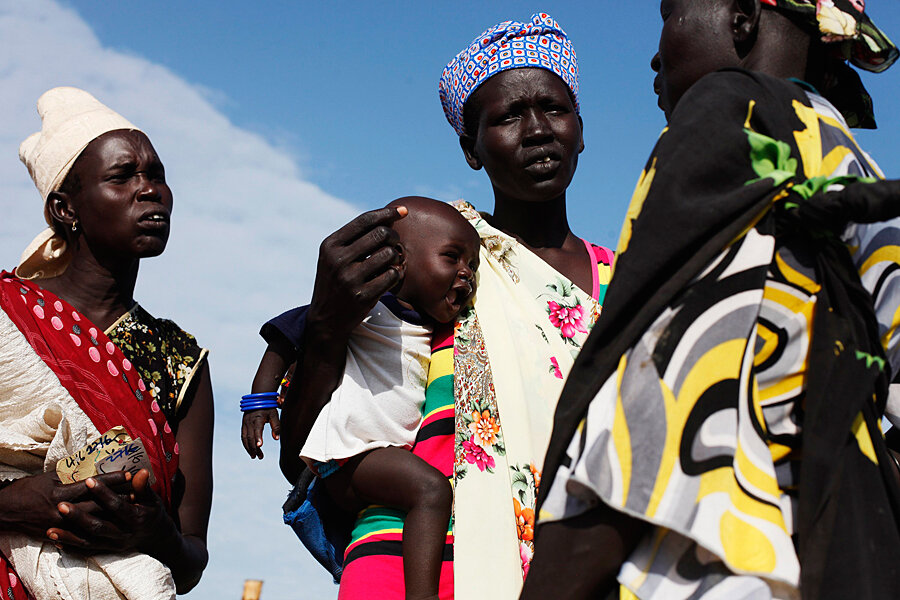Warnings mount of East Africa famine – is anyone listening?
Loading...
| Nairobi, Kenya
Nearly seven million people in South Sudan and Somalia are in urgent need of food handouts and several areas of both countries could slip into famine without increased and sustained international action, aid agencies are warning.
The red flag from humanitarian groups is based on sophisticated early warning systems that aid agencies use to push donors to pay up so food and other forms of help can be ready before a catastrophe is underway.
In the past, that money is rarely provided in time. In Somalia in 2011 more than half of the 258,000 victims of the food crisis died before famine was officially declared, and when funding faucets were fully opened.
Yet, the early warning systems are still seen as crucial. Earlier this year researchers fanned out across eastern Africa’s hinterlands to gather information on food available in markets and homes. Data was collected on how well-fed adults and children were, what farmers were planting in their fields, and on the condition and numbers of livestock.
That data got fed into a computer model first developed after the mass Africa famines of the 1980s. The model standardizes classifications of current crises and coming catastrophes.
Alerts often ignored
The idea behind the “famine early warning system” is to give the world unbiased data on which to help save potentially millions of lives.
But with competing demands for limited emergency aid money, donors, governments, and even humanitarian agencies ignore initial alerts, and respond only when it is almost too late, senior aid workers tell The Christian Science Monitor.
“The early warning systems are working well, we know what the situation is, and we know how bad it could get,” says Challiss McDonough, spokesman for the World Food Programme in East Africa, who is presently in South Sudan.
“The problem is that these are only technical tools, they do not automatically trigger the donor response that’s required to keep the situation from getting worse. We have the ability, the staff, the tools we need to scale up our response immediately. We just don’t have the resources.”
Gathering raw material to feed into the early warning systems is difficult enough. Stretches of both South Sudan and Somalia are mired in conflict, which limits researchers’ access. Even in peacetime, a lack of transportation or poor roads cuts areas off. Record-keeping can be rudimentary.
Still, researchers get out into the field most weeks. Key data include market prices and stocks of staple foods, household spending capacity, crop production, and the health status of the population.
Weather forecasts are included in the mix, as are developing political situations, especially the risk of increased conflict that blocks aid workers from affected populations, and forces many people to flee their homes and fields.
When the wheels start rolling
Together, all of the information feeds into what is universally known as the IPC, or the Integrated Phase Classification, which plots the severity of a food crisis in five levels, ranging from "generally food secure" to "famine/humanitarian catastrophe."
In the grim situation of Phase 5, more than two people in every 10,000 are dying a day, more than 30 percent of the population is malnourished, and there is less than 1 gallon of water and scant calories available to each person on a daily basis.
Yet the purpose of the early warning system is to motivate action far before Phase 5 is reached. When an IPC report puts a country in Phase 3’s ‘acute food and livelihood crisis,’ or a Phase 4 ‘humanitarian emergency’ – the aid world’s wheels should start to roll.
Food and medicines are pre-positioned where they will most be needed. Agencies draft in extra staff, vehicles, and aircraft for food drops and airlifts. Teams conduct regular visits to the most at risk areas, for rapid assessment missions to watch for the crucial signs that Phase 4 is tipping into a Phase 5.
All of this costs a great deal of money. The combined $1.8 billion UN and international aid appeal for South Sudan’s crisis is so far only 45 percent funded.
Somalia’s appeal for 2014 is so far less than a third funded and still needs $665 million, according to the UN’s Office for the Coordination of Humanitarian Affairs.
The UN’s emergency response fund, which pays out to help plug donor gaps, approved an extra $44.5 million for crises in east Africa on July 23, including $20 million for Somalia.
Sometimes you cry wolf
“Donor response is picking up, but more can always be done for every dollar if the money comes earlier rather than later,” says Rudi Van Aaken, acting head of the Food and Agriculture Organisation for Somalia, which manages the Food Security and Nutrition Analysis Unit, Somalia’s early warning system.
Mr. Van Aaken says a lack of donor response to the early stages of a food crisis is often based on skepticism about the accuracy of predictive models in the ebb and flow of world events. Also, there are many acute and ongoing immediate emergencies to tend to.
“The local donor offices at the embassies here want to go to their headquarters with the strongest case for funding that they can. But early on, all that we can offer them is tendencies and risks, not hard evidence,” he says.
“That cannot compete with competition for funding with other crises. This year there is Syria, there is Iraq, there is Central African Republic. We are often pushed to say, 'Yes, it’s going to go really bad.' The big reaction only comes when the F-word [famine] is out. And I do feel pressured to cry wolf sometimes.”






